|
21st and 27th April 2015 The British Cemetery
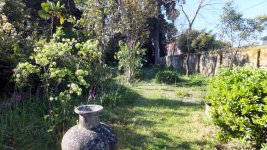 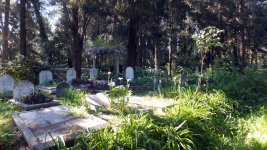 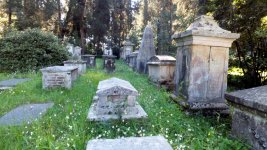
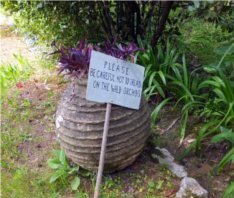 This is a remarkable place near the centre of Corfu Town which opened in 1814 and is still in use. Buried here are the Brits who were here when the island was a British protectorate, continuing with the many ex-pats who made Corfu their home. Quiet and peaceful, partly wooded, it is home to many wild orchids as well as other wild flowers. The late middle part of April seems to be a good time to go there. By our second visit all the lilies which lit up the open areas a week before had gone, and the orchids were past their best. We found the orchids did seem to have their favourite places to grow and these were predominantly in the older undisturbed parts. This is a remarkable place near the centre of Corfu Town which opened in 1814 and is still in use. Buried here are the Brits who were here when the island was a British protectorate, continuing with the many ex-pats who made Corfu their home. Quiet and peaceful, partly wooded, it is home to many wild orchids as well as other wild flowers. The late middle part of April seems to be a good time to go there. By our second visit all the lilies which lit up the open areas a week before had gone, and the orchids were past their best. We found the orchids did seem to have their favourite places to grow and these were predominantly in the older undisturbed parts.
The most noticeable Ophrys species was Ophrys ferrum-equinum, identified by pinkish lower half of the lateral sepals, the deeper coloured lateral petals and entire labellum. There was a great diversity of speculum markings on those present, with horseshoes upright and inverted, straight lines, circles and H shapes. I had hoped one of these might be O. spruneri, but none shows an obvious 3-lobed labellum.
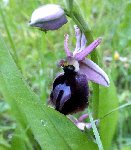 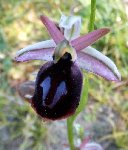 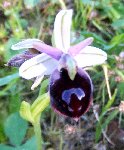 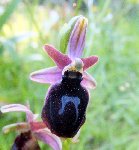 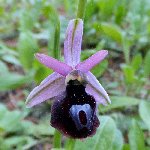
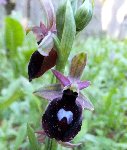 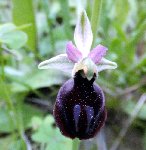 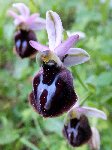 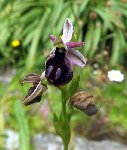
Also present in smaller numbers and as smaller, harder to find plants, were O. cornuta and O. bombilifera. Identification on these is straightforward, especially with the long `horns' on the former and the latter being un-confusable with any other species.
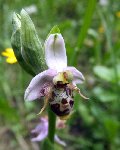 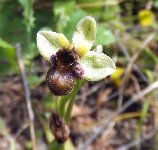
Ophrys lutea crops up in many places on the island. However I am inclined to pronounce the yellow Ophrys in the cemetery as O. phryganae. This is said to resemble O. lutea, but is more of a woodland plant, is more lax-flowered and has a pubescent labellum. They could be found singly or in groups here and there.
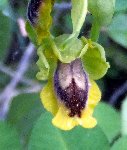 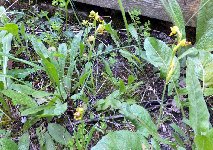
I had a list of the orchids known to inhabit the cemetery (no, I didn't find even half those on the list), but the Green-winged Orchid, Orchis morio, was not listed, nor its close relative O. picta. I have decided these are morio rather than picta based on the more denser cylindrical inflorescence, the colour variations, and the spur shape.
 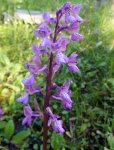  
The Orchis genus was also represented by Orchis laxiflora and O. italica. The loose-flavoureds tend to grow in groups, but seem to a degree of colour variation beyond what would be expected. Apart from the colours though, there are no other candidates for these variations to be a different species. The italicas are very obvious where they grow, and younger globular and older elongate flower heads can be found side by side. I particularly like the smiley faces on these!
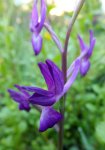    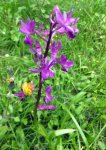
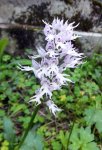  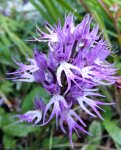
Other orchids in the cemetery are represented by the Pyramidal Orchid, Anacamptis pyramidalis, and Barlia robertiana. The Pyramidals are typical, pale, and unremarkable. The Barlias had finished flowering, but could not be confused with any other orchid. The were tall, robust, and can be found in groups.
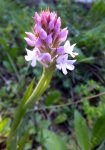  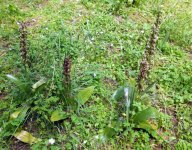
Finally there is the minefield presented by Serapias genus. I am quite unfamiliar with these orchids, find them a bit more difficult to photograph, and they seem to be quite variable in appearance within a species. Ideally you need to dis-assemble individual flowers for a more positive identification. Nevertheless, I think at least six species are growing in the cemetery, and I have tentatively put a species name to them; but would not object to being corrected on any of these.
|
Serapias lingua, the Tongue Orchid, is one of the commonest here. There is quite a bit of variation of the pink of the labellum, and its distribution. There are some quite large groups of this orchid to be found. This species is said to be identifiable by the coffee bean swelling at the base of the labellum, clearly seen in two of these photos.
|
  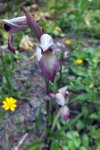 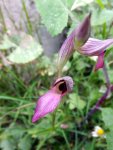 ![]()
|
|
Serapias cordigera seemed quite variable with the degree of overall colouration.
|
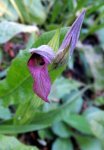 
|
|
Almost certainly Serapias vomeracea, from its size, form and appearance.
|

|
|
A rather handsome species which I take for Serapias politisii, which is presumed to be a self fertilising hybrid between S. parviflora and S, bergonii. It has been recorded from a number of the Ionian Islands.
|
 
|
|
For one of the more commonly encountered speies of this genus S. parviflora was under-represented in the flora here. Perhaps the hybrids have taken over.
|

|
|
Then there are these flowers, the unknown Serapias. Their pale, pink-veined, appearance bears little relation to any of the species in Delforge's book, but are probably a local variation of a well known species
|
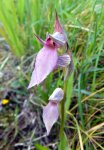 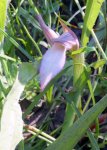 
|
|
|
|
|
    
|
|
|
